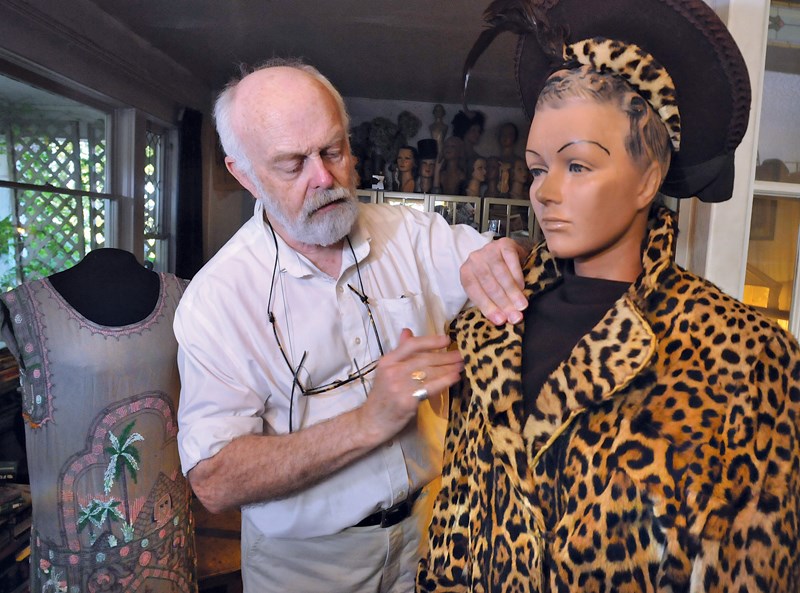In the Valley of the Kings, a British archaeologist treaded into a tomb which had known no sounds but the faint frequency of slow putrefaction for 3,000 years.
Archaeologist Howard Carter’s 1922 sojourn into the burial chamber of King Tutankhamun – and all the mystery and mysticism that stemmed from the boy pharaoh’s gold finery and quartzite sarcophagus – came to represent an entire culture and to influence countless others.
“When they opened his tomb there was a huge fad for things with an Egyptian theme,” notes fashion historian Ivan Sayers.
Sayers is the proud owner of an early 1920s dress that features the Sphinx and the Pyramids embroidered in beads.
“People were already getting psyched up about Egyptomania, and this dress was probably just part of that.”
Purchased in a Victoria antique shop, the “Nile green” outfit features Moorish arches and an image of the Sphinx with a facial expression Sayers likens to digestive discomfort.
Despite its shortcomings, the dress provides an “extremely kitschy” window into an era of archaeological discovery, Sayers says. It’s also indicative of the way African fashion – and the popular perception of African fashion – influenced international design.
Sayers is scheduled to discuss that relationship at a Sept. 17 fashion show at Corrigan Nature House.
Dubbed African Mtindo (a Swahili word loosely translated as ‘style’), the show is a fundraiser for girls leadership training in Kenya led by former North Vancouver resident Khaynga Wasike.
“The slogan is: Women take over the world,” she says with a laugh.
“I’m not kidding,” she explains before adding: “But I’m kidding.”
The eight-day conference is part of a larger movement to shrug off chauvinism and involve Kenya’s entire population in the leadership of the country.
The conference focuses on education, avoiding early pregnancy, general health, media influence, as well as government corruption and what can be done to eradicate it.
“After the training, they go on to become leaders,” Wasike says of the 150 girls expected to attend.
They’re hoping to raise $4,000 with the fashion show, which gets them close to the $6,000 Wasike expects to need to transport and feed the teens during the event.
The girls get a chance to meet young women who have graduated university and are working as professionals.
Besides networking, the girls are encouraged to submit proposals related to environmental initiatives, care for seniors, or “whatever it is their community is struggling with.”
The idea for a fashion show has been percolating for a long time, Wasike says.
“We wanted to share the concept of how African fashion, African clothing has influenced fashion.”
In his book detailing the obsession with ancient Egypt, author Ronald H. Fritze noted the culture was “comfortably familiar and intriguingly exotic.”
The blend of familiarity and exoticism is on full display in the last century of African fashion.
The popularity of certain clothes offers an insight into technology – for instance, the advent of sewing machines resulted in low priced high fashion, effectively democratizing style – as well as other aspects of history.
South Africa was once home to a thriving industry propped up by ostrich feathers.
As European women sought more decorative hats, ostrich farmers were shipping “literally thousands of pounds of ostrich feathers,” Sayers says.
The feather boom didn’t survive the First World War, he notes, as many exporters went bankrupt.
One of the recurring themes Sayers has encountered is the way Africa is romanticized and simplified.
“One of the classic images of Africa is leopard skin. To the broader world it’s exotic. In its original form, of course, it was meant also as a victory of man over nature because the leopards were predatory.”
Leopard prints have shown up in 18th century French silks, he mentions.
“It’s also seen as sexy. You know, a leopard skin bikini, well ... I’m not putting one in the show!”
The show is what Sayers calls “painless education.”
“It’s more than just a series of pretty dresses.”
Wasike agrees.
As much as there is to learn about trade routes and “mummy brown” dresses, the ultimate aim is to lift up the girls and women of Kenya.
“It’s not just a fashion show, it is an educational day,” Wasike says.
Wasike says she’s hoping to share a little bit of Kenya, and perhaps to encourage a few good people to help with her initiative.
“We want people to come and share.”
For more information about the event, visit whisca.eventbrite.com.



